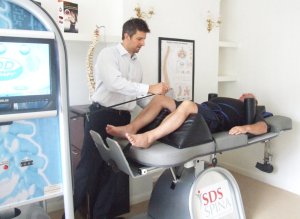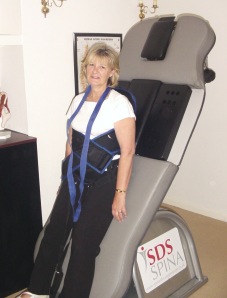This article examines the question of how to improve rehabilitation exercise compliance. This is particularly important for patients who are recovering from chronic back pain who have lost the discipline of regular activity.
Assuming that the prescribed exercises are not unduly painful, the question is not “how do we help people to exercise more”, rather it is “how do we help people to develop self-discipline”.
 Evidence from other industries demonstrates that setting goals and keeping a diary of the new habit is the most effective way to maintain self-discipline to arrive at a goal. I propose the use of pocket diaries as a key tool to improve rehabilitation exercise compliance for people with chronic back pain.
Evidence from other industries demonstrates that setting goals and keeping a diary of the new habit is the most effective way to maintain self-discipline to arrive at a goal. I propose the use of pocket diaries as a key tool to improve rehabilitation exercise compliance for people with chronic back pain.
At the bottom of this post you can get a word document which explains to patients the purpose of the diary and how they can benefit from using the diary (you can have this in your patient info folder in reception or to give to new patients.)
Background
 How many clinics just give their patients a set of printed or hand written exercise instructions and essentially leave it to the patient to get on with it … or not? I hear it all the time, patients don’t do their exercises.
How many clinics just give their patients a set of printed or hand written exercise instructions and essentially leave it to the patient to get on with it … or not? I hear it all the time, patients don’t do their exercises.
Patients are people, who are also in pain. Think of one thing you should do more of? Why don’t you?
Is it to do regular exercise, weekly budgeting, retirement planning, investment evaluation, losing weight?
Whatever it is, it’s not about the thing, it’s about self-discipline. To tackle exercise compliance therefore is to tackle self-discipline.
It is often said that the best innovation comes not from thinking “outside of the box”, but from thinking “Inside a different box”. So let’s leave exercise and examine what other industries do to instill and create self-discipline.
Thinking Inside A Different Box
Here are some examples of how other industries develop self-discipline:
Personal Development: In order to develop habits to get you to where you want in life, it is universally acknowledged that we need goals. Not just any goals, but WRITTEN down goals. (See Tony Robbins, Jim Rohn, Bryan Tracey et al)
Financial: ‘Too much month, not enough money’? (Michael Heppel). What is the first recommendation of any financial advisor when someone is having trouble making ends meet? Write down and record everything you spend. Then write down a budget and stick to it and record what you spend.
Weight Loss: You’ve seen the programmes of people who have been clinically obese for years. First they begin by recording everything they eat. Then they measure and write down their key stats, then they set a diet/lifestyle plan and as they begin they monitor and write down what they did and how they progress.
School Homework: My youngest daughter has a reading diary. Her school expects her to read something every day and then write down what she read with comments from a parent. In her mind, it is not an option for her to arrive at school without her teacher being able to see she has read something – even if that means reading in the car on the way to school!
The pattern is emerging and it isn’t rocket science. What about exercise?
Olympic athletes: They write down and plan every training session and write down what they actually did in that training session. It is impossible to reach that level without planning and recording.
Gym-goers: There are gym goers who arrive with a diary. They have planned their exercise and they tick off what they do as they go around the different cardio and strength stations. Whenever I do this myself, my workouts are 100% more effective … and fulfilling.
PATIENT EXERCISE COMPLIANCE
My principal interest is helping chronic back pain patients who have IDD Therapy Spinal Decompression treatment progress through their rehabilitation exercises. However, this works for any patient who NEEDS to be doing exercise for rehabilitation.
Pocket Diary: Patients should use a simple pocket diary to record their activity.
GOAL: On the first page they should write down their goal, strictly with a timeframe but that can be difficult for certain patients and there is a balance of compliance and unrealistic patient expectation.
PLAN 1: Give your patient the exercises they need to perform and give each exercise a short name. The patient will write down short names for each exercise they are going to perform in their diary. It is important that THEY write them in THEIR diary to hardwire their brain into the process.
PLAN 2: You should help them plan their first month of when and how many of each exercise they are going to do (this can include a walk to the shop to buy the paper). Here you will identify the time slots when it is feasible for them to actually fit the exercise in. Yes, we can all make time, but collecting kids from a swimming lesson or going to the pub with a friend creates excuse opportunities.
When you finish writing the plan, ask them one important question: “Are you going to do it?”
HABIT: It is well documented that it takes 30 days to form a habit. You need to hold their hand for that first month. By setting achievable targets they are more likely to be able to ACCOMPLISH the targets. That brings personal reward, fulfilment, belief and … self-discipline.
RECORD: Patient is going to write down EVERY activity they did and every exercise they did. They have to write it down in their diary.
Exercise is self-discipline and comes from within. If they need to get a buddy or partner involved, or even a personal trainer to help them, great, whatever works.
HOMEWORK
The killer point about the diary is the need to please others, ie you and not to lose face.
They have a written down plan and they have made a personal commitment to you and themself, verbally.
Tell them you want to see them in two weeks (or a month) and ask them to bring their (homework) diary. You are holding them accountable and the inky plan on the pages of their diary is far more likely to hold them accountable to their activity than an idea floating in their head, some scribbles on a piece of paper or an exercise video sitting in their inbox.
DIARIES
You can get some branded pocket diaries very cheaply, or just have plain ones. The cost is minimal so as a “value added service”, you can just give the diary to your patient or sell them at cost/ small profit.
CONCLUSION
Doing anything is always better than nothing. The diary helps instill the self-discipline to do what is required to help resolve chronic back pain.
Doing what is required leads to improvement and reduced pain. Improvement reinforces beliefs about what is possible. Beliefs reinforce self-discipline. Self-discipline leads to doing what is required, doing what is required leads to improvement …
Off the vicious and onto the virtuous circle.
To receive a document which explains to patients the purposes of using the diary as part of your compliance process, complete the form below.
About the Author
Stephen Small is Director of Steadfast Clinics Ltd
www.SteadfastClinics.co.uk
Conflict of interest: None
.





